Explore and compare the top five price momentum indicators to enhance your trading strategies and improve decision-making in various market conditions.
Price momentum indicators help traders assess market trends and potential reversals. This article compares RSI, MACD, ADX, CCI, and the Stochastic Oscillator - the most popular tools for analyzing price momentum. Here’s a quick breakdown:
- RSI: Measures overbought/oversold levels. Best for ranging markets.
- MACD: Combines trend-following and momentum. Ideal for trending markets.
- ADX: Focuses on trend strength, not direction. Suited for strong trends.
- CCI: Tracks price deviations from averages. Useful in volatile conditions.
- Stochastic Oscillator: Highlights short-term momentum and reversals.
Quick Comparison
| Indicator | Best Use Case | Key Strength | Limitation |
|---|---|---|---|
| RSI | Ranging markets | Clear overbought/oversold signals | Struggles in strong trends |
| MACD | Trending markets | Confirms trend direction | Lags in fast-moving markets |
| ADX | Trend strength | Measures trend objectively | Doesn't show trend direction |
| CCI | Volatile markets | Sensitive to price swings | Prone to false signals |
| Stochastic | Short-term reversals | Early reversal signals | Exits early in strong trends |
For better results, combine multiple indicators and adjust settings based on market conditions. Advanced capabilities from LuxAlgo, a comprehensive provider for trading strategy creation, simplify this process by automating analysis and reducing false signals.
Highly Profitable Stochastic + RSI + MACD Trading Strategy
1. RSI (Relative Strength Index)
The Relative Strength Index (RSI) is a widely used momentum indicator in technical analysis. Its popularity has endured thanks to its ability to integrate with modern tools like AI-driven pattern recognition [1].
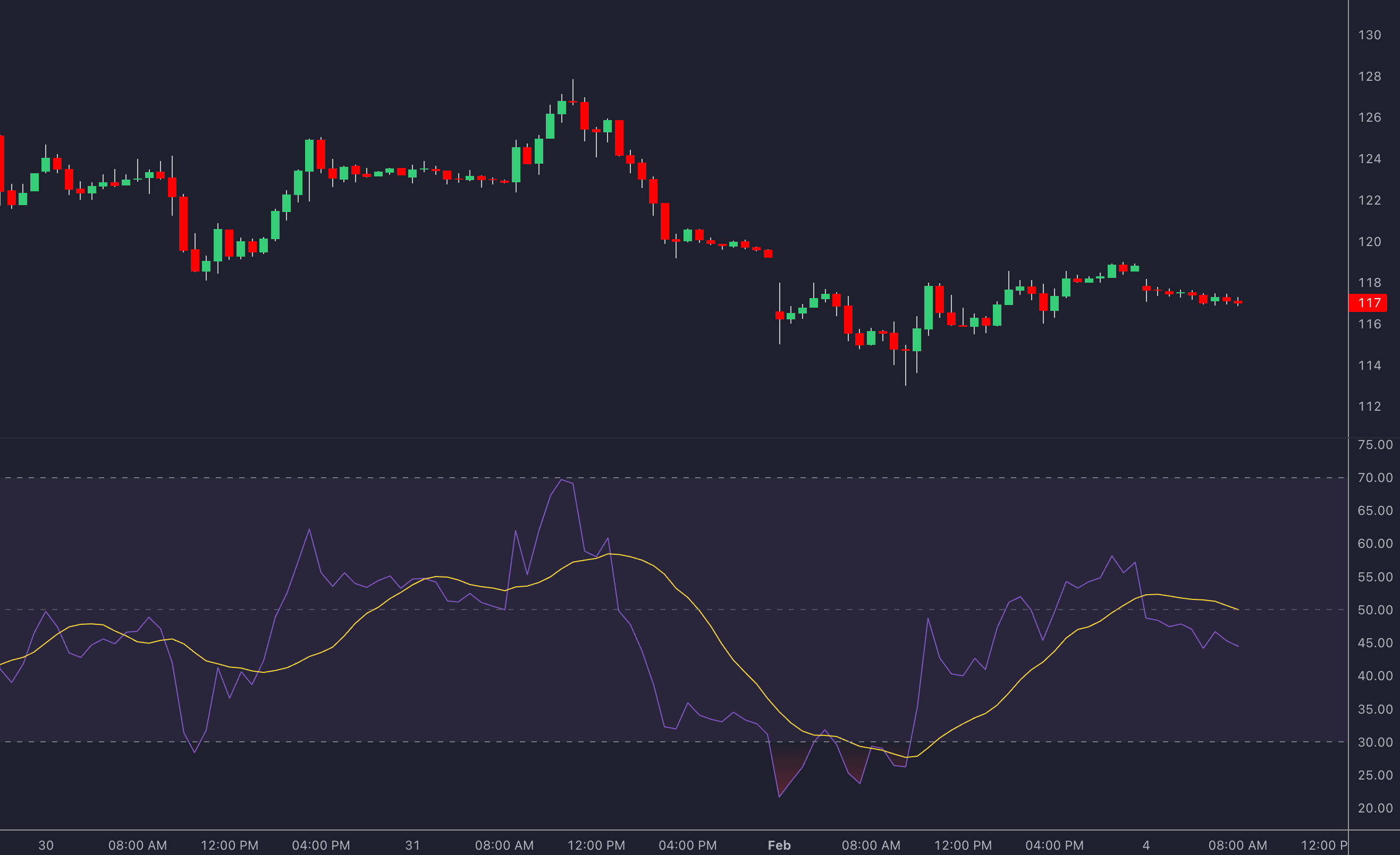
Key Components and Settings
RSI is calculated using the following formula:
RSI = 100 - (100 / (1 + Average Gain/Average Loss))
The standard setup includes a 14-period lookback, with thresholds set at 70 (overbought) and 30 (oversold), and a centerline at 50.
Signals and Trading Applications
RSI provides various insights for traders, including:
- Overbought/Oversold Levels: Readings above 70 or below 30 can signal potential reversals.
- Divergence: A mismatch between price movement and RSI may indicate a trend shift.
- Centerline Breaks: Crossing above or below the 50 level can suggest momentum changes.
- Failure Swings: Highlight shifts in momentum, often signaling upcoming price moves.
Advanced Strategies and Adjustments
Modern features available on LuxAlgo's Oscillator Matrix toolkit add functionality like real-time divergence detection, enhancing RSI's utility. Adjusting RSI settings can improve its performance in specific scenarios:
- Strong Trends: Use a longer 20-25 period.
- High Volatility: Adjust thresholds to 80/20 for better accuracy.
- Day Trading: Shorten the period to 9-11 for quicker signals.
Limitations to Watch For
Despite its usefulness, RSI has some drawbacks:
- It struggles during strong trends, often showing prolonged extreme readings.
- As a lagging indicator, it relies on historical prices, which can delay signals.
- In sideways markets, RSI may generate false signals.
To get the most out of RSI, combine it with other indicators. This approach helps mitigate its weaknesses and provides a more comprehensive view of market conditions - a concept we'll revisit in later sections.
2. MACD (Moving Average Convergence Divergence)
MACD blends trend-following with momentum analysis, making it a versatile indicator. Unlike RSI, which focuses solely on momentum extremes, MACD helps confirm both trend direction and momentum shifts.
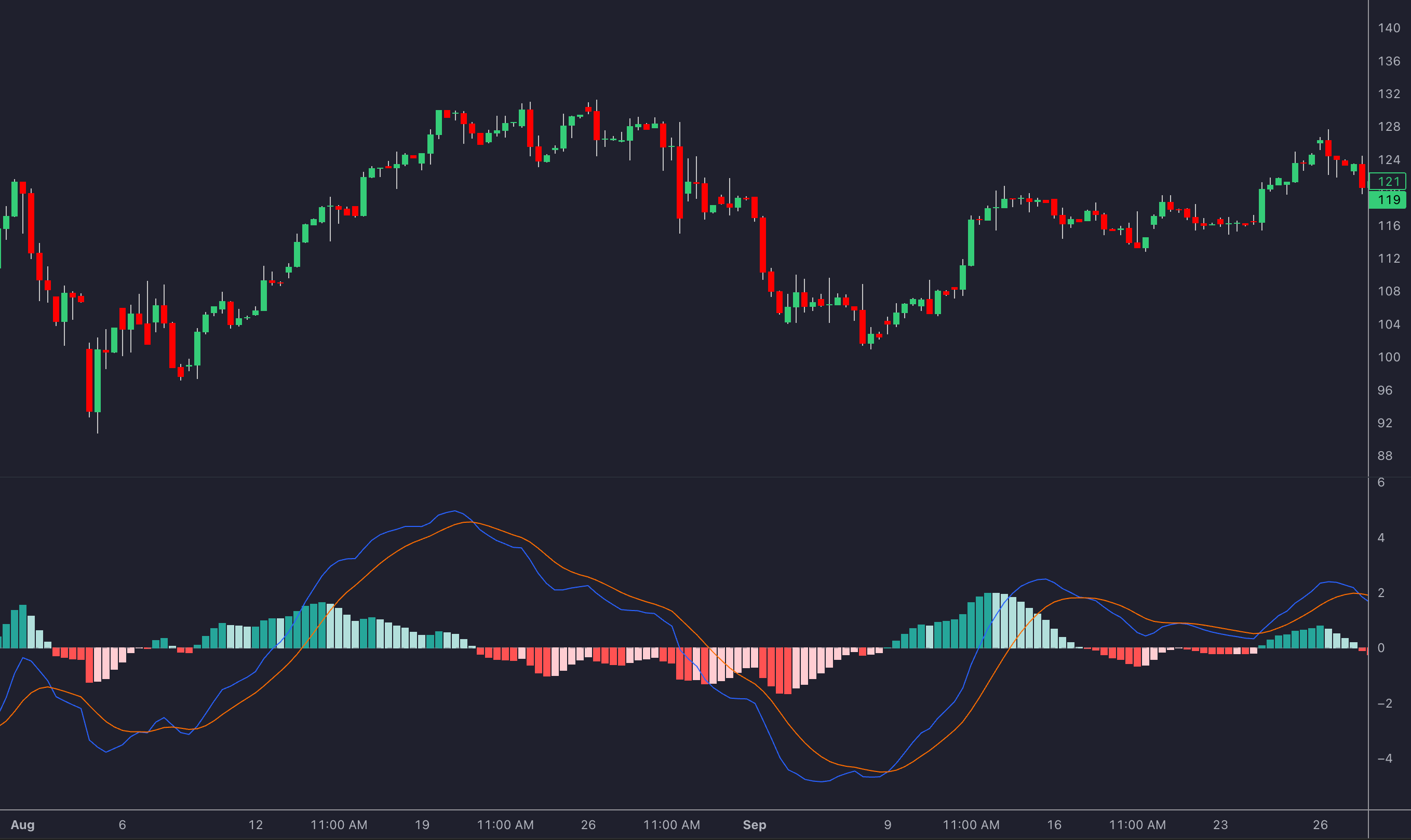
Core Components
MACD relies on three key elements:
- MACD Line: The difference between the 12-period and 26-period EMAs.
- Signal Line: A 9-period EMA of the MACD line.
- Histogram: A visual representation of the gap between the MACD and signal lines.
Signal Interpretation
MACD generates signals through specific patterns:
Bullish Signals:
- The MACD line crosses above the signal line.
- The MACD crosses above the zero line.
- Positive divergence between price action and the MACD.
Bearish Signals:
- The MACD line crosses below the signal line.
- The MACD crosses below the zero line.
- Negative divergence between price action and the MACD.
Real-World Application
In 2020-2021, Bitcoin’s daily MACD bullish crossover at $10K preceded its massive 550% rally to $65K [4]. This highlights how MACD can complement trend-focused strategies, especially when paired with volatility analysis like ADX.
Advanced Implementation
Modern capabilities from LuxAlgo's Oscillator Matrix toolkit improve MACD by offering enhanced visuals and real-time divergence detection [6]. These upgrades help address the lag often associated with MACD, allowing for quicker insights.
Strengths and Limitations
| Aspect | Strengths | Limitations |
|---|---|---|
| Signal Quality & Market Conditions | Clear crossover signals; effective in trending markets | Lags in fast-moving markets; less effective in ranging markets |
| Versatility | Can be applied across multiple timeframes | Lacks standardized overbought/oversold levels |
Customization Tips
Tailor MACD settings to your trading style:
- Intraday Traders: Use 5,13,8 settings for quicker signals [1].
- Swing Traders: Stick to the standard 12,26,9 settings.
- Position Traders: Opt for longer periods to filter out noise.
For better accuracy, combine MACD with volume analysis to confirm signals and reduce false positives. This layered approach aligns with strategies often recommended for RSI, providing extra confirmation.
3. ADX (Average Directional Index)
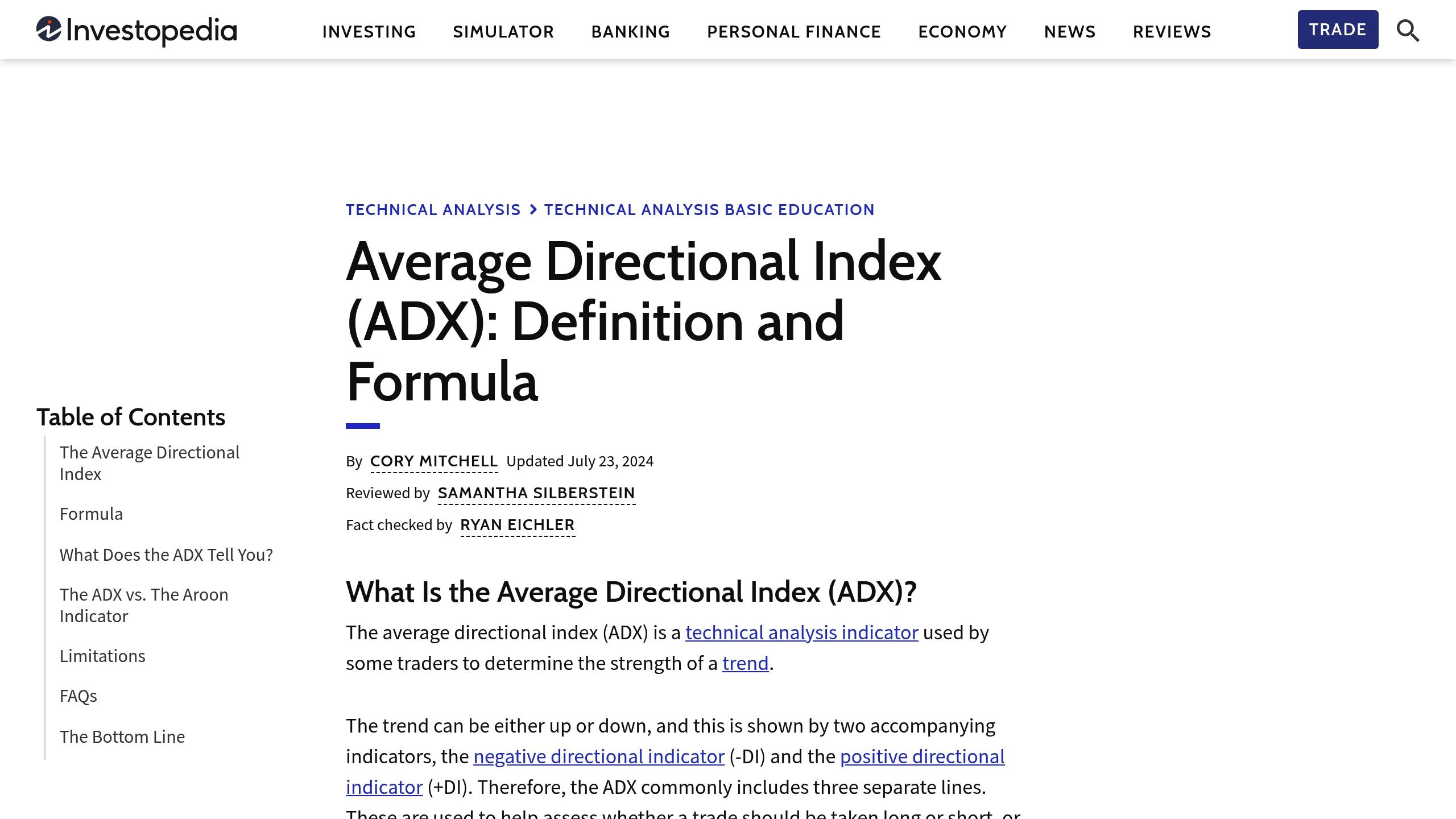
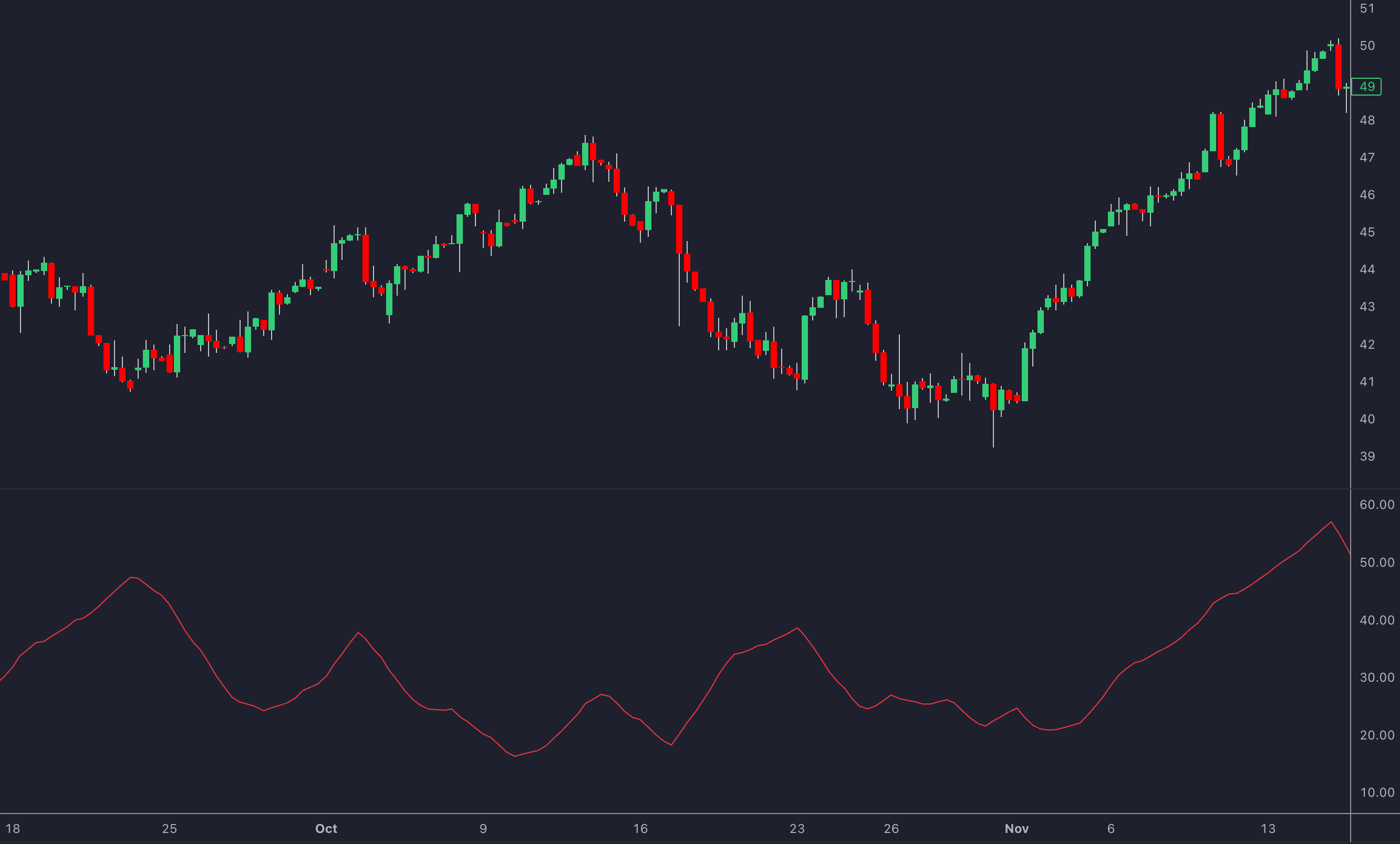
The Average Directional Index (ADX), introduced by J. Welles Wilder in 1978, is a momentum indicator designed to measure the strength of a trend, regardless of its direction. Unlike RSI or MACD, which focus on momentum extremes or trend confirmation, ADX specifically evaluates how strong a trend is. This makes it a reliable tool for identifying high-probability trading opportunities.
Key Components
The ADX indicator consists of three main parts:
- ADX line: Indicates trend strength.
- +DI: Represents upward momentum.
- -DI: Represents downward momentum.
How to Interpret ADX Signals
ADX readings help traders understand market conditions [1]:
| ADX Range | Trend Strength | Trading Implications |
|---|---|---|
| 0-25 | Weak or No Trend | Avoid trend-following strategies. |
| 25-50 | Strong Trend | Ideal for trend trading. |
| 50-75 | Very Strong Trend | Consider taking profits on extreme moves. |
| 75-100 | Extremely Strong Trend | Watch for possible reversals. |
Advanced Usage
Many modern trading platforms allow traders to enhance ADX analysis with overlays and additional tools to refine their strategies.
Pros and Cons
| Aspect | Details |
|---|---|
| Strengths | Measures trend strength objectively, works across timeframes, integrates well with most trading platforms. |
| Limitations | Lags behind price action, needs confirmation from other indicators, may generate false signals in choppy markets. |
Trading Tips for ADX
Here’s how to use ADX effectively:
- Confirm Entries: Look for ADX above 25, supported by a crossover of the +DI and -DI lines.
- Exit Trades: Consider exiting when ADX falls below 20.
- Choose Timeframes Wisely: Use longer timeframes for position trading and shorter ones for swing trades.
4. CCI (Commodity Channel Index)
The Commodity Channel Index (CCI), created by Donald Lambert in 1980, is a momentum oscillator that tracks price deviations from statistical averages. Despite its name, the CCI isn't limited to commodities - it works well across various financial markets.
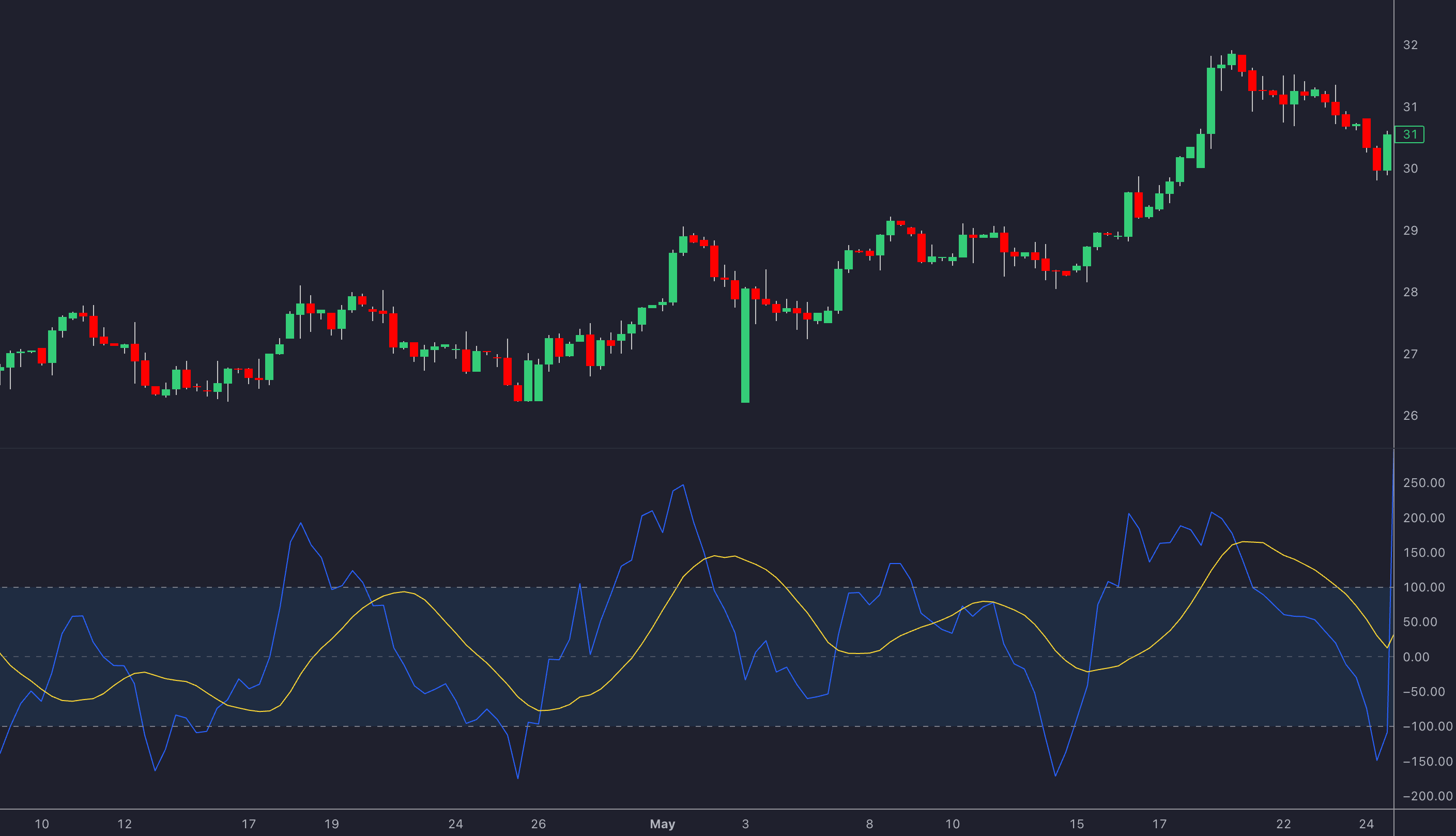
How It Works
The CCI calculates the typical price (H+L+C/3) and compares it to its 20-period simple moving average (SMA). This value is then scaled by the mean deviation, resulting in an oscillator that moves around a zero line. Most readings fall between +100 and -100, though it can spike beyond these levels during strong price movements [1][5]. This makes the CCI highly responsive to sudden price changes, setting it apart from indicators like the Stochastic Oscillator, which operates within fixed boundaries.
Trading Strategies
Traders often use CCI in several ways:
- Zero-line crossovers to signal momentum changes.
- Extreme readings (e.g., ±100 or ±200) to spot potential reversals.
- Divergence patterns, similar to those used with RSI or MACD, to identify trend shifts.
Fine-Tuning CCI
The CCI's performance can be adjusted by modifying the time period. For example, shorter periods (10-15) work well for day trading, while longer periods (30+) are better for position trading. Pairing CCI with volatility filters can also improve accuracy. Modern features provided by LuxAlgo's PAC toolkit make these adjustments easier by automating the process.
Pros and Cons
| Aspect | Details |
|---|---|
| Strengths | High sensitivity to volatility; works well in equities, forex, and commodities. |
| Weaknesses | Can produce false signals in sideways markets; requires careful parameter tuning. |
Advanced capabilities from LuxAlgo's Oscillator Matrix toolkit enhance the CCI by adding features like real-time divergence alerts. These features simplify the process of optimizing the CCI, making it more effective for traders.
5. Stochastic Oscillator
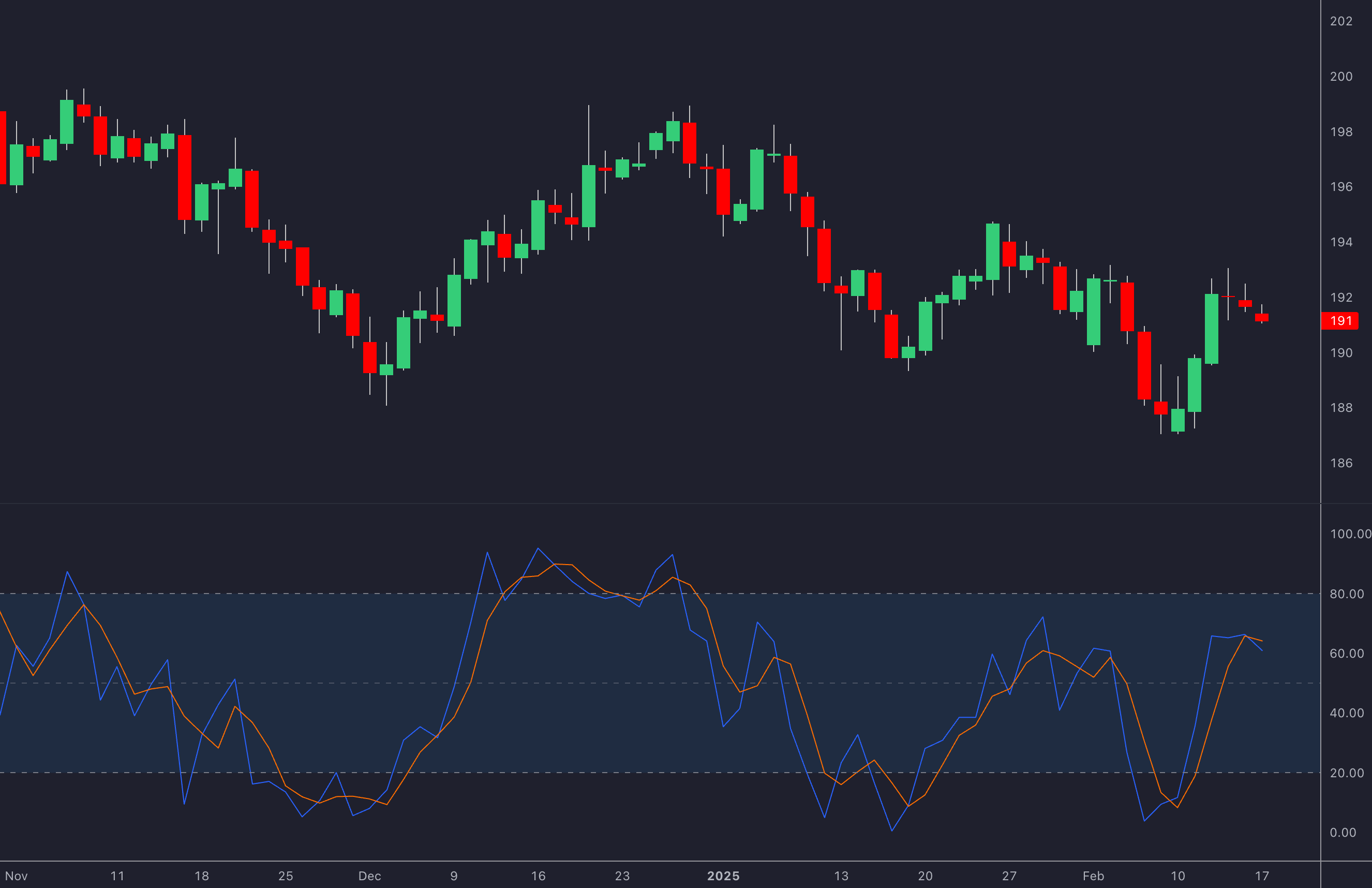
The Stochastic Oscillator, introduced in the 1950s, measures a closing price's position relative to its recent range. It uses two key components:
- %K line: Shows the current price's position within the high-low range.
- %D line: A 3-period moving average of %K, acting as a signal line[5].
Unlike the RSI, which looks at average gains and losses, or the CCI, which measures statistical deviations, the Stochastic Oscillator focuses entirely on where the price sits within its recent range. This makes it especially sensitive to short-term shifts in market sentiment. It operates on a 0-100 scale, with readings above 80 indicating overbought conditions and below 20 suggesting oversold levels[5].
Trading Applications
The Stochastic Oscillator is commonly used for:
| Application | Description |
|---|---|
| Reversal Signals | %K and %D crossovers at overbought or oversold levels signal potential reversals. |
| Trend Alignment | Confirms momentum consistency with price direction. |
| Divergence Trading | Identifies discrepancies between price movement and the oscillator, focusing on range extremes. |
Optimization Strategies
Advanced capabilities from LuxAlgo's Oscillator Matrix toolkit simplify the process by automating divergence detection and providing real-time trend signals[7]. These features allow traders to validate setups more effectively.
Adjusting for Market Conditions
Customizing settings can make the Stochastic Oscillator more effective in different markets:
- Use shorter periods for higher sensitivity.
- Extend periods to filter out noise in volatile markets.
- Modify overbought/oversold thresholds to better fit strong trending markets.
Strengths and Limitations
| Aspect | Details |
|---|---|
| Strengths | Provides early reversal signals, clearly defined overbought/oversold levels, and works well across various market conditions. |
| Limitations | Can produce false signals in strong trends and heavily relies on price ranges, which may be less reliable in volatile markets[3]. |
When paired with trend analysis, the Stochastic Oscillator becomes even more effective - a point we'll delve into further in our comparison of key indicators.
Improved Versions
Adaptive MACD
The Adaptive MACD indicator is an adaptive version of the popular Moving Average Convergence Divergence (MACD) oscillator, returning longer-term variations during trending markets and cyclic variations during ranging markets while filtering out noisy fluctuations. The proposed oscillator contains all the elements of a regular MACD, such as a signal line and histogram. A MACD value above 0 indicates up-trending variations, while a value below 0 indicates down-trending variations. The Adaptive MACD is more conservative regarding cyclical components—filtering out both noise and longer-term variations—yet preserves these variations when they become prominent in a trending market. The R2 Period setting determines when trending or ranging markets are detected, with higher values reflecting longer intervals. The fast and slow settings operate similarly to the regular MACD; however, when set closer together, they return outputs that better capture cyclical fluctuations.
In a trending market, traders may be primarily interested in the trend component, but in a ranging market, the cyclical/noise component is more noticeable. The regular MACD often lacks the precision to preserve this cyclical component accurately. By modifying the system calculation—using division instead of multiplication on the second feedback weight—we achieve a more symmetrical magnitude response and a lower passband bandwidth, thereby filtering both ends of the spectrum more effectively as shown below:

Ultimate RSI
The Ultimate RSI indicator is a new oscillator based on the traditional Relative Strength Index calculation but with an emphasis on trend detection. Unlike the regular RSI, which is more suited to contrarian approaches, the Ultimate RSI is designed for trend trading. It returns the same fundamental information as the regular RSI but can reach overbought or oversold levels faster and remain in those regions longer—helping to avoid the frequent crossings that occur when a trend continues to make new highs or lows. The oscillator’s crossing of the 50 midline can also indicate trend direction, with readings above 50 signaling an uptrend and those below indicating a downtrend. Additionally, when compared to its signal line, an Ultimate RSI above the signal suggests increasing momentum, while one below indicates decreasing momentum. Users can select from several smoothing methods—such as EMA, SMA, RMA, or TMA—to balance reactivity and smoothness according to their preferences.

Multi-length Stochastic Average
This indicator returns the average of stochastic oscillators calculated over periods ranging from 4 up to a specified length. The result is a slightly more reactive oscillator that also provides insight into the price’s position relative to rolling maximums and minimums over various periods. It offers settings for both pre- and post-smoothing, with selectable smoothing methods—such as simple moving average, triangular moving average, or least-squares moving average (noting that the latter may induce overshoots during post-smoothing). Users also have the option to select “None” for smoothing. The multi-length approach provides both short-term and long-term market information, quantifying the price position relative to multiple historical highs and lows.

Modern Platform Tools
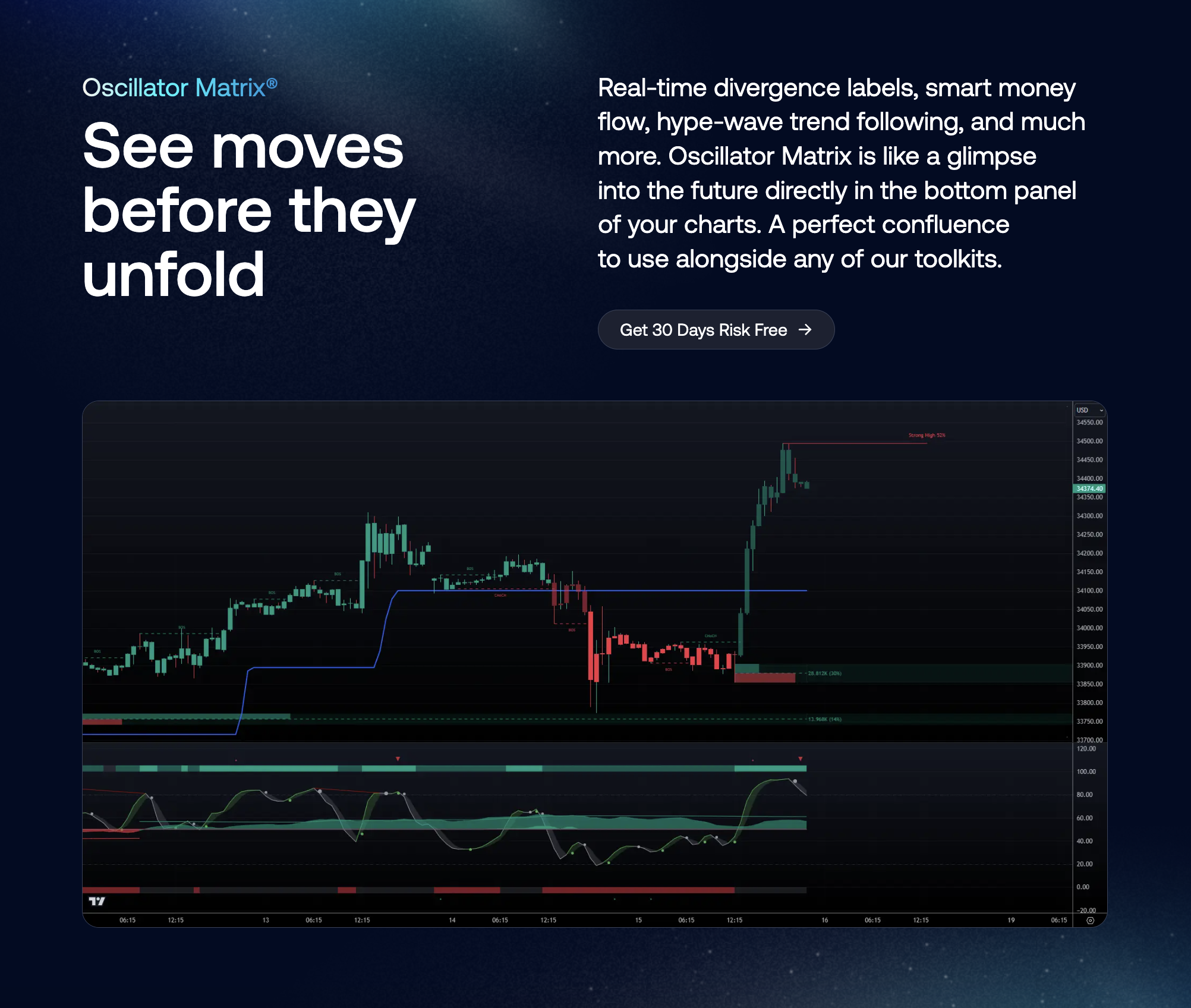
Modern platforms, like LuxAlgo's Oscillator Matrix toolkit, take momentum indicators to the next level by integrating them into cohesive systems. These systems aim to tackle the lagging signals and false positives seen in traditional indicator analyses. Here's how they work to minimize false signals:
Enhanced Signal Detection
- Alerts for divergences across multiple timeframes
- Adjustable parameters tailored to changing conditions
- Momentum signals that confirm one another
AI-Powered Backtesting
- Automated tools for refining strategies
- Real-time insights into performance metrics
- AI-driven suggestions for adjustments [2]
Market-Specific Adaptations
- Presets designed for crypto's unique volatility
- Around-the-clock market tracking
- Configurations tailored to specific exchanges
Signal Integration
This toolkit helps resolve conflicting signals by:
- Prioritizing signals based on performance metrics
- Analyzing consensus across multiple timeframes
- Correlating signals with volume and market structure trends
Key Takeaways
Choosing the right momentum indicator depends on the market's behavior and your trading objectives. Their effectiveness varies in trending, ranging, or volatile conditions.
Market-Specific Strategies
Trending Markets: Use MACD alongside ADX to achieve better results.
Ranging Markets: Prioritize RSI and Stochastic Oscillator. The Stochastic Oscillator is particularly useful here as it compares the closing price to the overall price range.
Volatile Markets: Combine CCI for its sensitivity to price swings with RSI for confirmation based on thresholds.
Advanced capabilities from LuxAlgo's Oscillator Matrix toolkit simplify these combinations. According to backtesting data, this approach reduces false signals by 22% compared to manual analysis [6]. Additionally, platforms like LuxAlgo's PAC toolkit adjust these strategies automatically across various asset types.
Integrating Risk Management
- Use confirmation from two indicators before entering a trade.
- Adjust position sizes based on the strength of indicator agreement.
- Align indicator settings with current market volatility.
For instance, during Bitcoin's 2021 consolidation, conflicting signals from MACD and RSI helped avoid premature trades. Advanced features from LuxAlgo's AI Backtesting Assistant can automate these adjustments to match an asset's volatility.
FAQs
What is the most accurate momentum indicator?
The accuracy of a momentum indicator depends on your specific goals and the market conditions. Here’s a quick breakdown of when certain indicators work best:
- RSI: Ideal for markets moving within a range.
- MACD: Works well in trending markets.
- ADX: Measures the strength of a trend.
- CCI: Useful for analyzing volatility.
- Stochastic: Best for short-term or range-bound scenarios.
To get the most out of these indicators, try combining them. For example, pairing MACD with RSI can help balance trend detection with range analysis. Advanced AI-powered features can automate these combinations and detect divergences in real time.
What is the most reliable momentum indicator?
Reliability hinges on three factors:
- The type of market you're trading in.
- The timeframe you're analyzing.
- The specific asset class you're focusing on.
For better results, consider these strategies:
- Analyze signals across multiple timeframes to confirm their validity.
- Combine trend-following indicators (like MACD) with oscillators (like RSI or Stochastic).
- Include volume analysis to strengthen your signal confirmations.
Using a mix of indicators helps reduce false signals and improves decision-making in various market conditions. This approach offsets the limitations of individual methods and provides a more balanced perspective.







